Are you ready to explore the magical world of flowers? Let A take you on a journey to discover stunning floral varieties. From delicate forget-me-nots to regal irises and dazzling dahlias, we’ll show you flowers that will amaze you.
Learn when each flower blooms, their special qualities, and why you’ll love them. This guide is for everyone, from gardeners to flower lovers. It will help you appreciate flowers more and inspire you to make beautiful arrangements and gardens.
What wonders are waiting in the flower world? Get ready to be amazed as we share the secrets of these beautiful plants.
Enchanting Forget-Me-Not Flowers
Forget-me-not flowers brighten up any spring garden with their lovely pink, white, or blue colors. They grow well at the front of borders, making a beautiful display as spring arrives.
When They Bloom: Spring
Forget-me-not seeds start growing quickly when the soil is warm. They need a cold period before they bloom, usually after their first year. They grow best in temperatures between 60°F and 65°F.
Why We Love Them: Their adorable pink, white, or blue blooms charm at the front of borders. Plant native species for best results.
For the best results, plant native forget-me-not species like Myosotis alpestris, laxa, macrosperma, or verna. Avoid the non-native Myosotis sylvatica as it can spread too much. It’s better to grow it in containers or remove its seeds.
Forget-me-not flowers symbolize love and remembering. The blue petals stand for deep, lasting love. The yellow center shows the heart of a person. These flowers have inspired many artists, writers, and musicians, making them a favorite in gardens.

You can add forget-me-not flowers to your life by planting them, making flower arrangements, or wearing them as accessories. Their beauty and meaning will bring joy and inspiration to everyone.
Daphne: The Sweet-Scented Shrub
Spring is coming, and the daphne plant shows it’s here. It’s famous for its beautiful flowers and sweet smell. This makes it a top choice for gardeners who want to brighten up their yard early in the season.
When It Blooms: Late Winter to Early Spring
Daphne plants start to bloom in late winter to early spring. They bring color and a lovely smell to the garden when it’s just waking up. The scent of daphne is unique and signals the start of spring.
Why We Love It: Its Pretty Blooms and Heavenly Fragrance
What makes daphne so special is its lovely flowers and sweet smell. Whether it’s the bright pink flowers of Daphne Mezereum Rubra or the strong scent of Daphne Odora, these plants add magic to any garden.
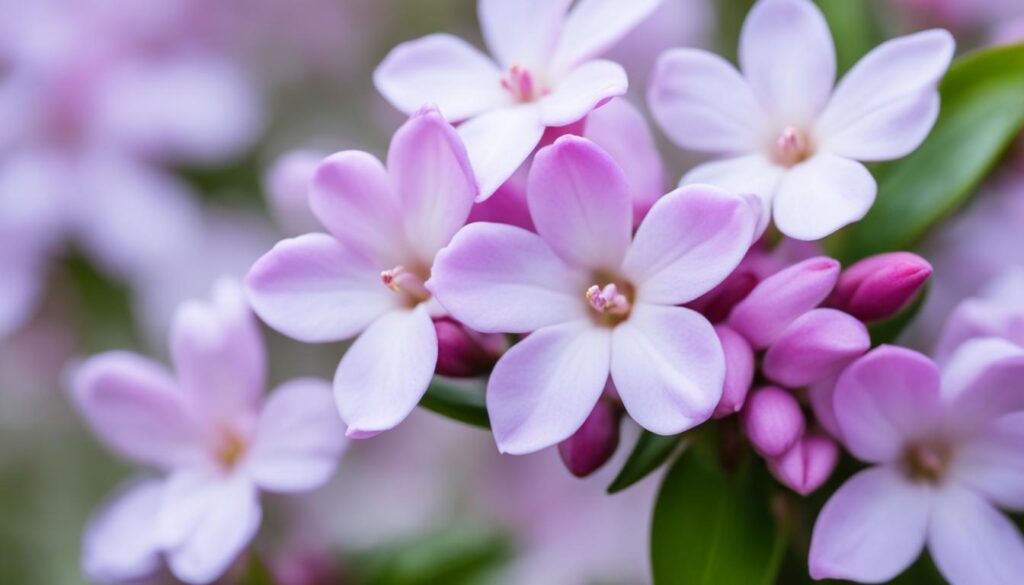
Daphne plants are great for many gardens because they like well-draining soil and some shade. They’re perfect for small gardens too. With varieties like Daphne Cneorum ‘Eximia’ and Daphne ‘Jacqueline Postill’, there’s a daphne for every garden.
If you want to bring early spring magic to your garden, or just enjoy the sweet smell of daphne, this flowering shrub is perfect. Its arrival means the warmer months are coming soon.
Snowdrops: The Delightful Early Bloomers
Snowdrops are the first signs of spring, bringing joy to gardeners waiting for winter to end. These flowers bloom early, often through the snow, showing hope and new life. Their white blooms are a favorite in gardens that stay cold.
Snowdrops are tough, growing in zones 3-9 and liking many soils. They spread out, creating lovely groups over time. Their sweet smell and pretty flowers are a treat for the senses.
These flowers are great because deer and rabbits don’t like them. They’re easy to care for, perfect for those who want beautiful flowers early in spring. Snowdrops can be found in gardens, woodlands, or pots, signaling spring’s arrival.
There are about 20 types of Galanthus and over 500 kinds of the common snowdrop (G. nivalis). Gardeners can pick from many varieties, like the strong ‘Atkinsii’ or the light ‘Scharlockii’. Each type adds its own special touch to the spring garden.

To see these early spring flowers, plant snowdrop bulbs in the fall. This lets them get ready before snow comes. With the right care, these cold-weather flowers will come back every year, welcoming spring.
Irises: Regal Beauties in a Rainbow of Hues
Irises are truly regal flowers, with blooms in a stunning range of colors. They go from the palest pink to the deepest purple and nearly black. These easy-care perennials bloom in late spring to early summer. They add elegance to any garden.
When They Bloom: Late Spring to Early Summer
Irises are a must-have for flower lovers. They come in a rainbow of colors and bloom reliably every year. Their blooms start in late spring and last into early summer. This makes them a vibrant addition to the garden.
Why We Love Them
Irises are loved for their beautiful blooms in every color. Purple irises symbolize wisdom and compliments, while blue irises evoke feelings of faith and hope. Yellow irises show passion, and white ones represent innocence and purity.
Bearded Irises need at least six hours of full sun to do well. They should be planted with their rhizomes just below the soil. It’s important to divide them every few years to stop them from getting too crowded.
- Bearded Irises can get diseases like Iris borer and leaf spot fungus. So, proper care and winterization are key.
- Deadheading spent blooms helps the plant focus on growing and blooming again.
- Well-drained soil is crucial for Bearded Irises to thrive.
Irises have a long history, inspiring the fleur-de-lis symbol of the French monarchy in the Middle Ages. Today, they still amaze gardeners and flower lovers with their wide range of colors and timeless beauty.
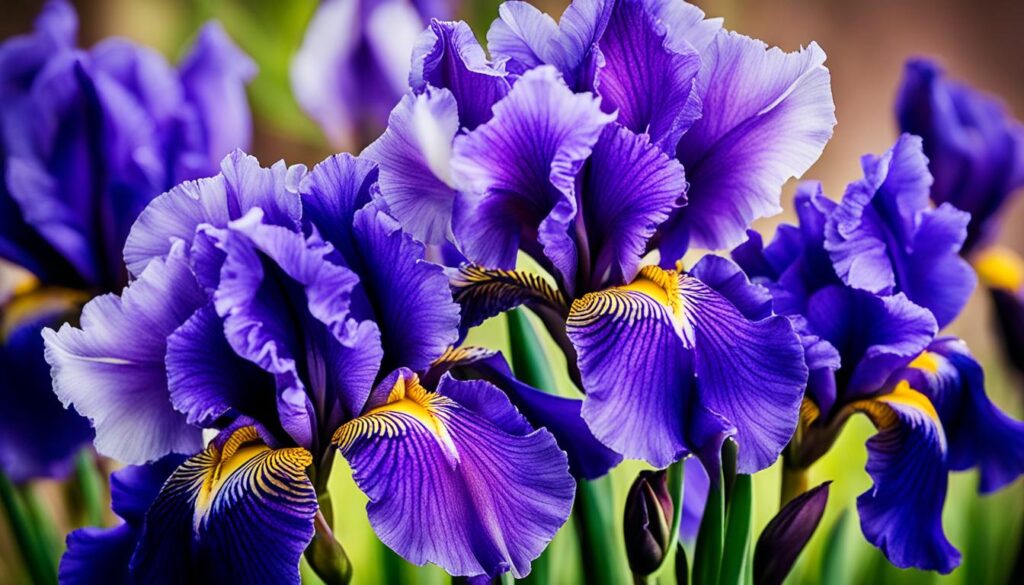
flowers with a Dazzling Dahlia Display
Dahlias are true showstoppers, with many varieties from tiny to huge blooms in every color. These late summer flowers and fall flowers bloom from late summer to fall. They add vibrant color to gardens.
When They Bloom
Dahlias bloom from late summer to fall. They are a must-have for gardens wanting a bright display of flower varieties and flower colors.
Why We Love Them
Whether you like the small pom-poms or the big dinner-plate dahlias, they are a delight. Their variety in shape, size, and color makes them stand out in gardens or arrangements.
The Dazzling Dahlia Show at the Greenwich Botanical Center was in its 15th year in 2023. It drew hundreds to see the many dahlia types. Over 500 dahlia varieties were shown, including some not yet named. Visitors could buy dahlia blooms to add to their gardens.
| Event Details | Statistics |
|---|---|
| Event Duration | 5 hours (10:00 a.m. to 3:00 p.m.) |
| Dahlia Varieties Showcased | Hundreds |
| Dahlia Bloom Sale | Started at 3:00 p.m. |
| Dahlia Arrangement Auction | Proceeds directed towards future events |
| Attendees | Welcomed to take home dahlia blooms |
| Organizers | Expressed gratitude to all supporters |
Whether you’re a pro at gardening or just love flowers, dahlias will amaze you. From small pom-poms to big dinner-plate dahlias, these flowers show the beauty and variety of nature.
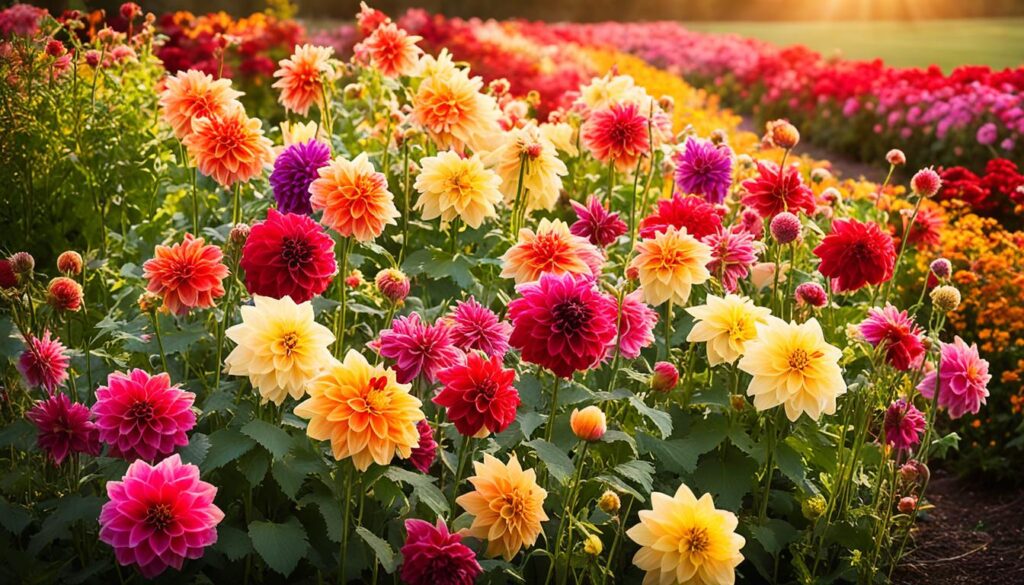
Winter Aconites: Early Nectar for Pollinators
As winter starts to fade, the winter aconite flowers bloom early. These bright yellow flowers are a big help to pollinators when there’s not much else around.
Winter aconites are in the Eranthis genus and belong to the Ranunculaceae family. They are from southern Europe, the Balkans, and Asia. Now, they also grow in Northern Europe, in USDA zones as low as 4.
Why are winter aconites so great? They bloom even when it’s as cold as 40 degrees Fahrenheit. They bloom before snowdrops and crocus do. Their flowers last about eight weeks before they go back underground. This makes them a key food source for bees, flies, and other pollinators.
They are also deer and rabbit resistant. This is great for gardeners in the north who have trouble with these animals. The plants can spread by seed, but they get along with other early spring flowers like snowdrops.
To grow your own winter aconites, plant the tubers in the early fall after soaking them in warm water. They like soil that’s rich in humus and drains well. They can even grow in the shade under big trees. With their bright flowers and help to the ecosystem, winter aconites are perfect for any spring garden.

| Characteristic | Details |
|---|---|
| Bloom Time | January to March, depending on location |
| Plant Height | 5 inches (13 cm) |
| Plant Spread | 4 inches (10 cm) |
| Hardiness | USDA Zones 4-8 |
| Soil Requirements | Humus-rich, well-draining, alkaline |
| Pollinator Value | Vital early nectar and pollen source |
| Deer/Rabbit Resistance | Highly deer and rabbit resistant |
Fritillaria: The Nodding Bell-Shaped Charmers
Fritillaria, also known as Checkered Lily or Snake’s Head, are unique spring flowers. They have fun, bell-shaped blooms that nod on long, grassy foliage. These fritillaria flowers bloom in mid-spring, adding whimsy to the garden. Plus, rodents tend to leave the bulbs alone, making them a reliable choice for gardeners.
The fritillaria plant shows off dangling, bell-shaped blooms in many colors. You’ll see oranges, butter yellows, pale whites, and plum-colored hues. These spring flowers with their bell-shaped flowers and bulb flowers create an elegant display in the garden. They are sure to delight both gardeners and those who pass by.
If you want to add quirky charm to your spring garden, the Fritillaria is a great choice. It’s also a reliable and rodent-resistant bulb flower. With its unique look and easy care, this bell-shaped flower is a must-have for flower lovers.
When They Bloom: Mid-spring
The Fritillaria, or Checkered Lily, blooms in mid-spring. It brings whimsical nodding, bell-shaped flowers to the garden. This makes the Fritillaria a great match for other early-spring flowers like daffodils, tulips, and hyacinths.

Planning your garden or just enjoying nature? The Fritillaria’s mid-spring bloom time is sure to delight. With its long, grassy foliage and beautiful flowers, this spring flower signals the warmer months ahead.
Helenium: Sunny Blooms for Summer Gardens
Helenium, also known as Sneezeweed, is a top choice for summer gardens. These flowers come in bright orange, gold, and sunny yellow. They are loved by bees, butterflies, and other helpful insects. Heleniums are easy to care for and add a burst of color to any garden.
Why We Love Them
Helenium plants grow 30-48 inches tall and are hardy in zones 3 to 8. They love full sun and rich soil with lots of organic matter. It’s best to divide them every 3 to 5 years to keep them healthy and blooming well.
The Royal Horticulture Society has given top awards to many Helenium types. These include Butterpat, Feuersiegel, Moerheim Beauty, Rubinzwerg, and Sahin’s Early Flowerer. You can also find double or semi-double flowers in Double Trouble and Moerheim Beauty.
| Helenium Cultivar | Bloom Time | Plant Height | USDA Hardiness Zones |
|---|---|---|---|
| Mardi Gras | Late June – October | 3-5 feet | 4-8 |
| Moerheim Beauty | Late Summer – Fall | 3-5 feet | 3-8 |
| Pumilum Magnificum | Late Summer – Fall | 2 feet | 3-8 |
Whether you like the bright orange, warm golden, or rich red-brown colors, Heleniums will brighten your garden. They bring joy and attract many pollinator plants.

Love in a Mist: The Romantic Edible Flower
Discover the captivating charm of Love in a Mist, an enchanting annual flower. It delights the senses with its beauty. Known as Nigella, this self-sowing beauty is a beloved summer bloom.
It has delicate, fern-like foliage and whimsical, blue-hued flowers. Love in a Mist adds romance to any garden. It’s not just pretty; it’s also versatile in the kitchen.

Love in a Mist belongs to the Nigella genus with about 20 species. It’s an easy annual to grow in full sun and well-drained soil. The plant grows 18 inches tall, with a bushy habit perfect for borders, beds, and containers.
It comes in various colors like blue, white, pink, and lavender. Varieties like ‘Miss Jekyll’, ‘Persian Jewels’, and ‘Mulberry Rose’ add more variety. They show the flower’s versatility and fit many garden styles.
Love in a Mist is edible. You can use its flowers and seeds in cooking. The seeds are popular in Indian and Middle Eastern dishes for their nutty taste. They add flavor to curries, breads, and more.
If you want a beautiful garden or to try new foods, Love in a Mist is great. It self-sows, giving you lots of summer flowers every year. It’s a delight for your eyes and taste buds.
Clematis: Vining Vertical Garden Beauty
Clematis is a favorite vine that brings elegance to gardens. These flowers bloom from spring to late summer. They make any fence, arbor, or lamp post look beautiful.
There are over 30 types of clematis for every gardener. These vines grow well in USDA Hardiness Zones 4 to 9. Make sure to plant the clematis crown 3 to 4 inches below the soil for strong roots.
Bloom Time and Pruning Considerations
Clematis are split into three groups based on when they bloom and how they grow. Group 1 blooms early, while Group 2 and 3 bloom later. Cutting them back is key to keeping them healthy and looking great.
- Group 2 clematis, like the classic ‘Guernsey Cream’, bloom early.
- Group 3 clematis, such as ‘Princess Diana’ and ‘Etoile Violette’, bloom later and need more cutting back.
- The ‘Sweet Summer Love’ and ‘Sapphire Indigo’ are popular Group 3 clematis for their many flowers and non-vining nature.
With their different bloom times and pruning needs, there’s a clematis for every gardener. These flowers will make any outdoor space magical.

Cornflower: The Fringed Summer Stunner
Cornflower, also known as Bachelor’s Button, brightens summer gardens with its fringed blooms. These come in pink, white, and the famous cornflower blue. They bloom early to mid-summer and keep flowering with regular deadheading. Cornflowers bring a burst of color to summer borders and are great for cut flowers.
When It Blooms: Early to Mid-Summer
The cornflower is a summer highlight. Its bright blooms start in early to mid-summer. With the right care and deadheading, they keep flowering, making the season longer.
Why We Love It
The cornflower’s fringed petals in pink, white, and blue are loved by gardeners. These cornflowers are easy to grow and a favorite for all gardeners. Regular deadheading means they keep blooming, filling the summer with color and joy.
| Bloom Time | Flower Color | Growing Conditions | Maintenance |
|---|---|---|---|
| Early to Mid-Summer | Pink, White, Cornflower Blue | Full Sun, Well-Drained Soil | Regular Deadheading |
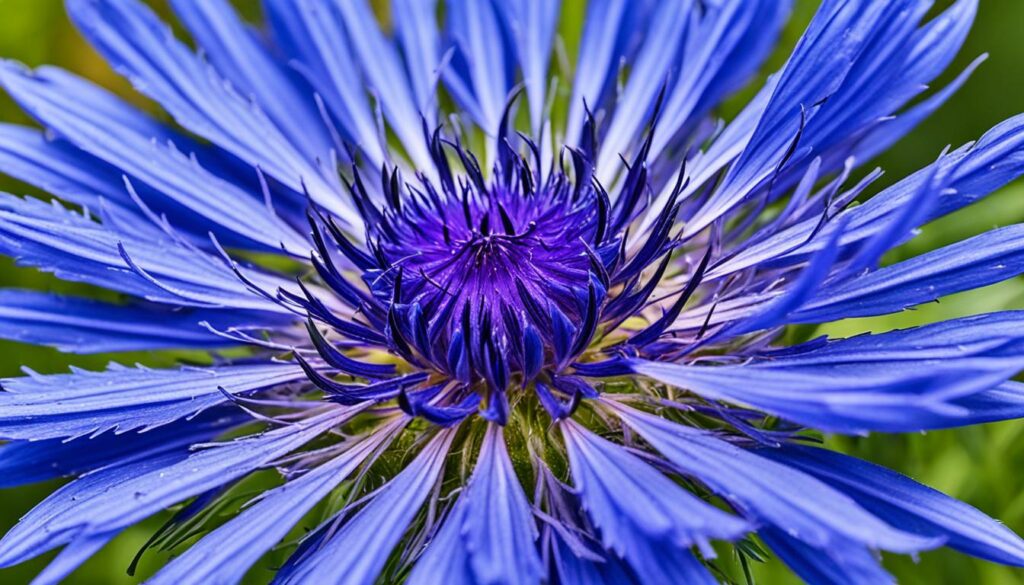
The cornflower is perfect for adding color to your summer garden or as a cut flower for bouquets. Its lovely blooms and easy care make it a top choice for any garden.
Bleeding Heart: The Whimsical Heart-Shaped Delight
Bleeding Heart is a beautiful perennial flower. It makes gardens look lovely with its heart-shaped flowers in late spring. These flowers are a great food source for hummingbird-friendly gardens early on.
The flowers of Bleeding Heart are delicate and hang down. They come in pink and white colors. This adds a fun touch to any spring garden. They like cool places and do well in shade or a bit of sun. This makes them great for many garden spots, like rock gardens or flower beds.
When It Blooms: Late Spring
Bleeding Heart flowers bloom early in spring. They love cool weather and may sleep through the summer heat. So, they signal the start of spring.
Starting Bleeding Heart from seeds can be hard, but they’re easy to care for once they grow. They need soil that’s a bit acidic and not too dry. They should be watered well in summer. With the right care, Bleeding Heart can bloom beautifully for many years.
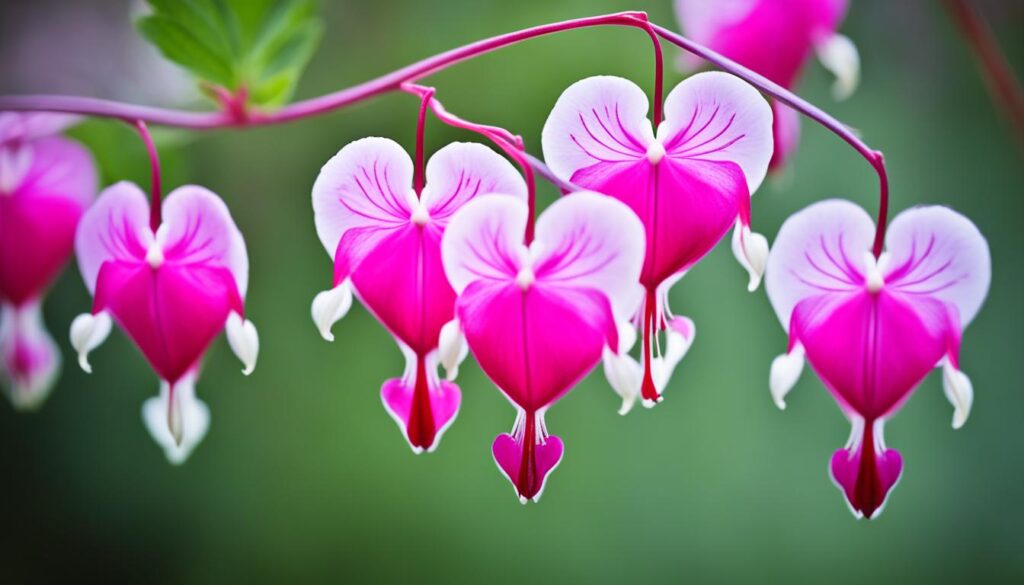
If you like the plant’s fun look or its help to pollinators, Bleeding Heart is a great choice for your garden. Its special look and usefulness make it a top pick for anyone who loves perennial flowers.
Lavender: Fragrant Perennial Swaths of Color
Lavender is a favorite perennial that enchants with its sweet scent and purple flowers. It does well in summer, creating beautiful colors and smells that draw in bees. Planting lavender together makes your garden look and smell amazing. Make sure to pick a type that fits your area’s weather.
When It Blooms: Summer
Lavender blooms in summer, filling the air with its lovely scent. Munstead Lavender (Lavandula angustifolia) is a great choice, growing 12 to 18 inches tall. It’s perfect for small gardens and borders.
For the best growth, keep lavender plants 12 to 18 inches apart. Prune English lavender in spring to keep it bushy and shaped right. Lavender is more winter hardy than lavandin (Lavandula x intermedia), making it a good choice for your garden.
The best time to pick lavender is just before the flowers open fully. This keeps the flowers smelling great for months. You can dry the stems for many uses, like making potpourri or adding to recipes.

Azaleas: Spring’s Flowering Shrub Beauties
Azaleas are a favorite flowering shrub that welcome spring with bright colors. They come in many colors, from soft pastels to bold jewel tones. These perennial flowers bloom in dense clusters, making a beautiful sight when planted together. They are perfect for adding spring beauty to your garden.
Azaleas love acidic, well-drained soils and can grow in partial shade. They bloom many times from early spring to late summer. This means they keep your garden colorful for a long time. With the right care, like fertilizing and pruning, your azaleas will look great every year.
Choose from classic red, soft pink, or bold lavender for your azaleas. These flowering shrubs add beauty and charm to your garden. Add them to your landscape for a lively and welcoming spring garden.



